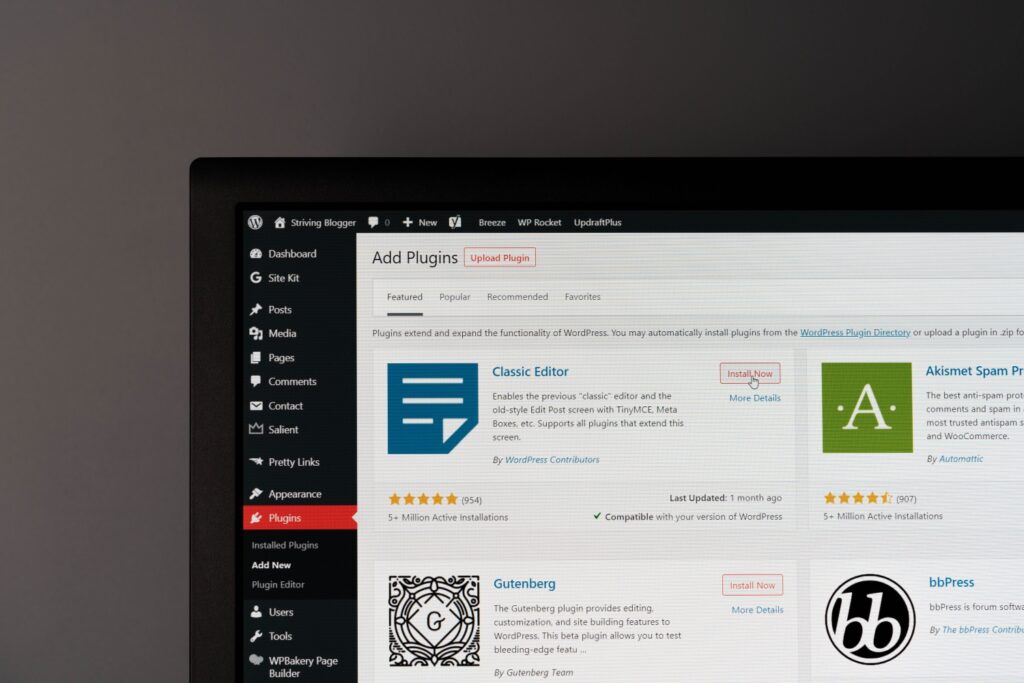WordPress is a popular content management system that allows users to create and manage websites. Page builders are tools that can be added to WordPress to help users design and create custom layouts and designs without any coding knowledge. They provide a user-friendly interface that allows users to drag and drop elements and customize their website in real time. In the next article, we will compare code-based and visual page builders available for WordPress and their pros and cons.
Using a page builder for your WordPress website has many benefits. Here are some of the key advantages:
- Customization: Page builders allow you to create unique and customized designs for your website that stand out from the crowd. You can choose from a range of templates and design elements, or create your own.
- Ease of use: With a user-friendly interface, page builders make it easy for anyone to create a website without any coding knowledge.
- Efficiency: By using a page builder, you can save time and money on website development as you don’t need to hire a developer or designer.
- Flexibility: Page builders give you the flexibility to change and update your website quickly and easily, without having to rely on a developer or designer.
Visual Page Builders
Visual page builders allow users to create and customize website designs using a drag-and-drop interface. They provide a range of design elements, such as pre-built templates, widgets, and modules, that can be easily added to a page. The user can then customize the design by adjusting the size, color, and layout of the elements. Visual page builders require no coding knowledge, making them accessible to users of all skill levels.
Key features of visual page builders include:
- Drag-and-drop interface for easy customization
- Pre-built templates and modules for quick design
- Real-time preview of changes
- Customizable design elements, including fonts, colors, and spacing
- No coding knowledge required
Pros and Cons:
Advantages of using a visual page builder include:
- Ease of use for users with no coding knowledge
- Fast and efficient design process
- Access to pre-built templates and design elements
- Real-time preview of changes
- Cost-effective compared to hiring a developer or designer
Disadvantages of using a visual page builder include:
- Limited customization options compared to coding
- Potential for slow website loading speeds
- Limited control over the website’s code
- Dependence on the page builder’s updates and compatibility with other plugins and themes
Examples of Visual Page Builders
Some popular visual page builders for WordPress include:
- Elementor: A popular page builder with a drag-and-drop interface, custom widgets, and a visual form builder.
- Divi: A page builder with a range of pre-built templates and modules and customizable design elements.
- Beaver Builder: A drag-and-drop page builder with a live front-end editing interface.
- WPBakery: A page builder with a visual editor and pre-built design elements.
The next section will explore code-based page builders and their pros and cons.
Code-Based Page Builders:
Code-based page builders are tools that allow users to create and customize website designs using a combination of drag-and-drop interface and code. They provide more flexibility and customization options compared to visual page builders, as users have greater control over the website’s code. Code-based page builders typically require some knowledge of HTML, CSS, and JavaScript.
Key features of code-based page builders include:
- Combination of drag-and-drop interface and code editing
- Access to more customization options and control over the website’s code
- Real-time preview of changes
- Customizable design elements, including fonts, colors, and spacing
- Requires some knowledge of HTML, CSS, and JavaScript
Pros and Cons
Advantages of using a code-based page builder include:
- Greater flexibility and customization options
- More control over the website’s code
- Ability to create unique and custom designs
- Potential for faster website loading speeds
- Cost-effective compared to hiring a developer or designer
Disadvantages of using a code-based page builder include:
- Steeper learning curve and requires some knowledge of HTML, CSS, and JavaScript
- Longer design process compared to visual page builders
- Potential for errors and bugs in the code
- Dependence on the page builder’s updates and compatibility with other plugins and themes
Examples of Code-Based Page Builders
Some popular code-based page builders for WordPress include:
- Beaver Builder: A drag-and-drop page builder with a live front-end editing interface that allows users to add custom code.
- Oxygen: A visual drag-and-drop page builder with a focus on customizable code and advanced features.
- Visual Composer: A page builder that combines drag-and-drop editing with customizable code options.
- SiteOrigin: A page builder that allows users to add custom CSS and JavaScript code, in addition to using drag-and-drop editing.
In the next section, we will compare visual page builders and code-based page builders and help you decide which one is right for your WordPress website.
Visual Page Builders vs. Code-Based Page Builders
When choosing between visual page builders and code-based page builders, there are several factors to consider. Here, we will compare the two types of page builders to help you decide which one is right for your WordPress website.
- Ease of Use:
Visual page builders are generally considered easier to use than code-based page builders. They feature a drag-and-drop interface allowing users to create and customize website designs without coding knowledge. This makes them a great choice for beginners or those who are not familiar with coding.
On the other hand, code-based page builders require some knowledge of HTML, CSS, and JavaScript. This can make them more challenging to use for those who are not familiar with coding.
- Customization:
When it comes to customization options, code-based page builders offer more flexibility than visual page builders. They allow users to access and edit the website’s code directly, which makes it possible to create unique and custom designs.
Visual page builders, on the other hand, offer limited customization options. While they do provide users with pre-designed templates and design elements, users may be limited in terms of customizing the code.
- Speed:
In terms of website loading speed, code-based page builders tend to be faster than visual page builders. This is because visual page builders often rely on additional scripts and stylesheets, which can slow down website loading times.
- Cost:
Visual page builders are often included with WordPress themes or available as free plugins, making them a cost-effective choice for website owners. Code-based page builders, on the other hand, may require a separate purchase or subscription, which can add to the cost of building a website.
- Compatibility:
It is important to ensure that the page builder you choose is compatible with your WordPress theme and other plugins. Visual page builders are generally more compatible with a wide range of themes and plugins, while code-based page builders may have more compatibility issues.
So, which one is right for your WordPress website?
If you are a beginner or do not have any coding knowledge, a visual page builder may be the best choice for you. It offers ease of use and is generally more cost-effective.
If you are an experienced developer or designer and want more control over the website’s code and design, a code-based page builder may be the better choice for you. It offers greater flexibility and customization options.
Ultimately, the decision between visual page builders and code-based page builders depends on your specific needs and preferences. Be sure to consider all of the factors above before making a decision.


